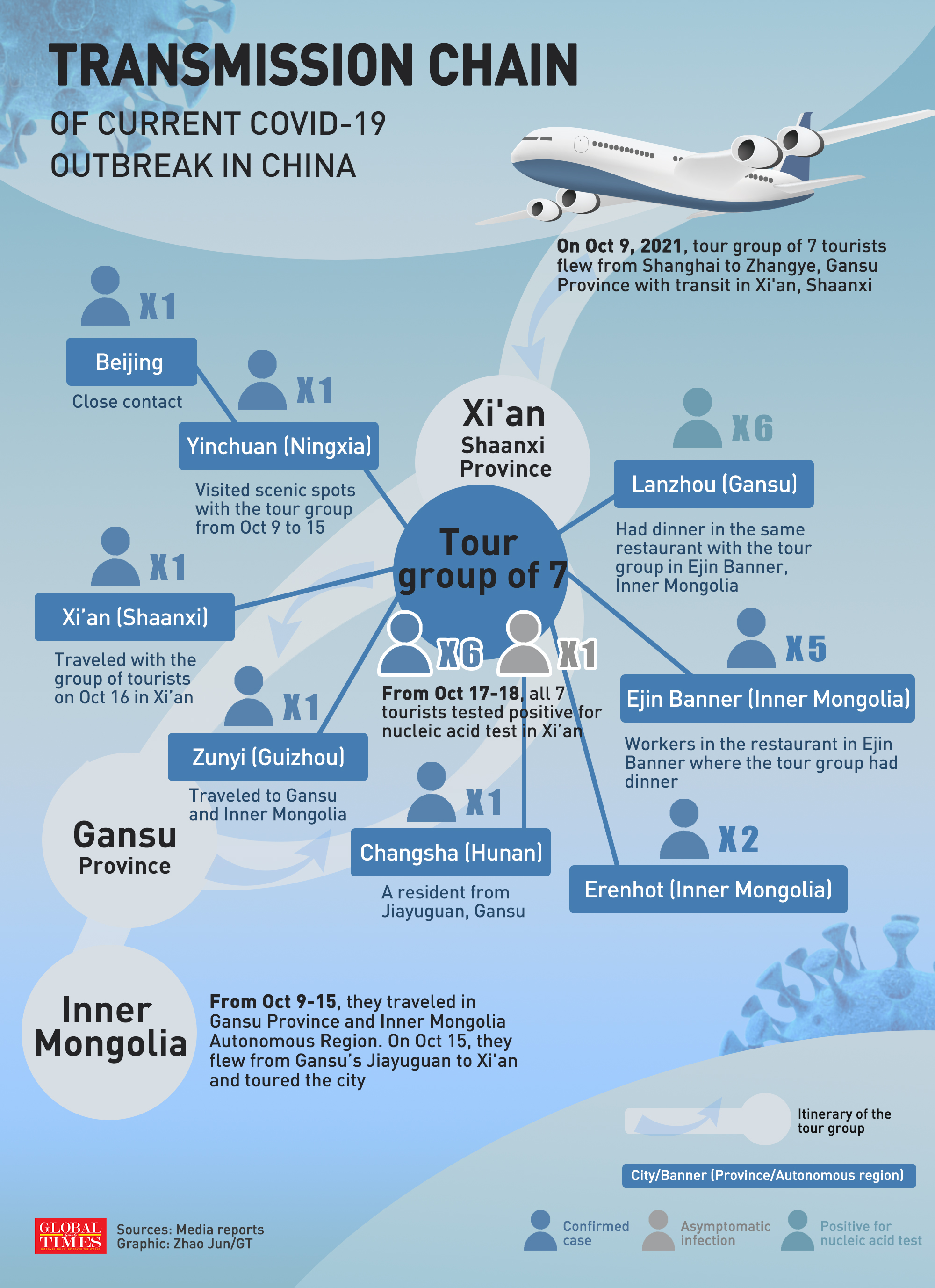
A high-speed train is ready to depart from Xi'an, capital of Northwest China's Shaanxi Province on Monday to Ordos, North China's Inner Mongolia Autonomous Region. Photo: cnsphoto
Virus that has triggered new outbreaks of COVID-19 linked to a tour group of seniors from Shanghai that have affected several regions of China likely stemmed from overseas, Chinese health experts said, as more than 20 positive cases linked to contacts of the group have been reported so far.
The group, which crisscrossed provincial regions in China's north and northwest, likely came into contact with the virus which may have arrived through port cities in Inner Mongolia Autonomous Region, although where exactly it came from and how it came into China is unknown, health experts said, noting the prevalent COVID-19 variants such as Delta now circulating globally could survive longer on products in cold weather, which may have triggered community transmission.
Beijing on Tuesday reported a locally transmitted COVID-19 case who returned to the capital from Northwest China's Gansu Province, another case linked to the tour group that had spread the virus to seven provincial regions and cities as of Tuesday, including port cities in Inner Mongolia and capital of Shaanxi Province.
The new case broke Beijing's record of no community transmitted cases for more than 70 days. The patient was a close contact of a confirmed case from Northwest China's Ningxia Hui Autonomous Region, surnamed Ai, who in turn was a confirmed contact of the Shanghai tour group. The Beijing case was on the same train as Ai.
A couple from Shanghai who were tested in Xi'an, capital of Shaanxi on Saturday, were the first to test positive in this latest outbreak. The couple was part of the tour group along with five other seniors, and had traveled in Gansu Province, Inner Mongolia and Shaanxi. Later, the other five tourists also tested positive in Xi'an.
Two streets in Beijing's Fengtai district are under closed management, and people from outside are advised not to visit the two streets. Fengtai district government said at a press conference Tuesday that the district will increase the frequency of disinfection in public venues, limit the number of visitors in indoor venues and restaurant opening times.
Fengtai has tracked 258 close contacts of the confirmed case, and a local school which had contact with one close contact was asked to suspend classes for a week from Tuesday. All faculty, staff and students have been tested.
Imported via ports? The seven seniors on the group tour tested negative in Shanghai before departure, and tested negative again on October 13 in Inner Mongolia, but their road trip from October 9 to 15 went through several cities, including Ejin Banner which borders Mongolia, which is experiencing a resurgence of the virus. The country registered 1,303 new COVID-19 cases in the last 24 hours.
On Tuesday, Ejin Banner reported five confirmed COVID-19 cases and the port city of Erenhot reported two, the health commission of Inner Mongolia said.
For the two positive cases in Erenhot, although they did not have direct contact with the tour group, they live in the same residential community as a hotel cleaner who had close contact with the tour group. The status of the cleaner is unknown.
From Monday 7 am, Ejin Banner had restricted movement both into and out of the region, and shut down the Ceke Port, the third-largest land port in Inner Mongolia. It would be a 48-hour temporary restriction, local officials said at a press conference on Tuesday.
An employee from the epidemic leading group of Alxa League which administers Ejin Banner told the Global Times on Tuesday that since Ceke Port has been closed, freight drivers from Mongolia are not allowed through.
He said prior to the outbreak, drivers from Mongolia had to return the same day as soon as they finished loading freight. Vendor streets close to the port were open for tourists who had green health QR codes.
Wang Guangfa, a respiratory expert at Peking University First Hospital, told the Global Times on Tuesday that the source of the latest infections was likely imported from overseas, as China has cleared its local infections long time ago and the sporadic outbreaks since the Wuhan outbreak were all related to imported sources.
"But how exactly the virus [this time] came to China, where it came from and which Chinese city first contracted the virus remain unknown," Wang said, noting that unknown factors may result in the further spread of the flare-up, and health authorities should speed up identifying the connections between cases in different regions and locating the source.
Prior to the new outbreak, several Chinese border cities including Khorgas, a port city in Northwest China's Xinjiang Uygur Autonomous Region that borders Kazakhstan had reported infections since October.
Compared with port cities that have frequent personnel exchanges, dealing with outbreaks in freight-related port cities is more complicated, analysts said.
Zhang Yuexin, an expert specializing in epidemic control and prevention based in Xinjiang told the Global Times on Tuesday that the possibility that loopholes in ports in Inner Mongolia that triggered the domestic outbreak could not be ruled out.
He said it is impossible for testing and disinfecting goods to cover each corner of each piece, and previous experience relating to ports suggests the virus on goods could easily spread to personnel who come into physical contact with contaminated goods accidentally or who fail to wear masks properly, Zhang said.
With the cold weather, newer prevalent variants such Delta could survive longer, Zhang said.
The latest flare-up also reveals deficiencies in communication between cities, analysts said.
The Shanghai couple first confirmed positive for COVID-19 in Xi'an on Saturday, but their nucleic acid testing showed an abnormal result on Friday in Jiayuguan, Gansu Province, as they were preparing to leave for Xi'an.
After they arrived in Xi'an, they were informed of the abnormal results and went for another test. However, they visited several scenic spots in Xi'an while awaiting the results.
Jiayuguan health authorities should have contacted Xi'an to inform them of the couple's abnormal results, and Xi'an should have quarantined or restricted their movements through technological means, such as turning their digital health codes red while waiting for the second test results, instead of allowing them to move around with a green code, analysts said.
Precise zero-tolerance epidemic strategyChina has successfully dealt with several sporadic infections after the Wuhan outbreak with its precise zero-tolerance epidemic strategy that strikes a balance between epidemic prevention and normal economic activities.
The flare-up has seen affected provincial regions temporarily close some tourist spots, suspend transportation services and place some streets under closed management, but their measures are not one solution fits all.
Wang said that China should stick to its current epidemic strategy before it is ready to reopen to the world as the global pandemic is not under control, and as a developing country, lacking proper measures would result in lots of cases that could overwhelm Chinese medical resources.
Though there is no timeline for when China will lift border restrictions, the country will do so after meeting a number of requirements, including figuring out the efficacy of the vaccines and taking into consideration the global pandemic situation, according to Wang.

Transmission chain of current COVID-19 outbreak in China. Graphic: Zhao Jun/GT





